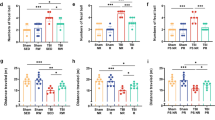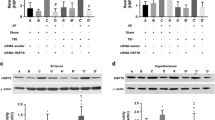Abstract
Physical exercise (PE) is an effective method for improving cognitive function among patients with traumatic brain injury (TBI). We previously demonstrated that PE with an infrared-sensing running wheel (ISRW) system provides strong neuroprotection in an experimental animal model of stroke. In this study, we used fluid percussion injury in rats to simulate mild TBI. For rats, we used both passive avoidance learning and the Y-maze tests to evaluate cognitive function. We investigated whether PE rehabilitation attenuated cognitive deficits in rats with TBI and determined the contribution of hippocampal and cortical expression of heat shock protein 20 (HSP20) to PE-mediated cognitive recovery. In addition to increasing hippocampal and cortical expression of HSP20, brain-derived neurotrophic factor (BDNF), and the tropomyosin receptor kinase B (TrkB) ratio, PE rehabilitation significantly attenuated brain contusion and improved cognitive deficits in the rat model. Furthermore, reducing hippocampal and cortical expression of HSP20 with an intracerebral injection of pSUPER hsp20 small interfering RNA significantly diminished the PE-induced overexpression of hippocampal and cortical BDNF and the TrkB ratio and also reversed the beneficial effect of PE in reducing neurotrauma and the cognitive deficits. A positive Pearson correlation was found between HSP20 and BDNF, as well as between HSP20 and TrkB, in the hippocampal and cortical tissues. We thus conclude that post-ischaemic ISRW exercise rehabilitation attenuates cognitive deficits, as well as brain contusions, in TBI rats by stimulating the cerebral HSP20/BDNF/TrkB signalling axis.





Similar content being viewed by others
References
Sterr A, Herron KA, Hayward C, Montaldi D (2006) Are mild head injuries as mild as we think? Neurobehavioral concomitants of chronic post-concussion syndrome. BMC Neurol 6:7. https://doi.org/10.1186/1471-2377-6-7
De Beaumont L, Theoret H, Mongeon D, Messier J, Leclerc S, Tremblay S, Ellemberg D, Lassonde M (2009) Brain function decline in healthy retired athletes who sustained their last sports concussion in early adulthood. Brain 132(Pt 3):695–708. https://doi.org/10.1093/brain/awn347
Guskiewicz KM, Marshall SW, Bailes J, McCrea M, Cantu RC, Randolph C, Jordan BD (2005) Association between recurrent concussion and late-life cognitive impairment in retired professional football players. Neurosurgery 57(4):719–726 discussion 719-726
Archer T (2012) Influence of physical exercise on traumatic brain injury deficits: scaffolding effect. Neurotox Res 21(4):418–434. https://doi.org/10.1007/s12640-011-9297-0
Andelic N, Bautz-Holter E, Ronning P, Olafsen K, Sigurdardottir S, Schanke AK, Sveen U, Tornas S et al (2012) Does an early onset and continuous chain of rehabilitation improve the long-term functional outcome of patients with severe traumatic brain injury? J Neurotrauma 29(1):66–74. https://doi.org/10.1089/neu.2011.1811
Franckeviciute E, Krisciunas A (2006) Evaluation of factors influencing effectiveness of kinesitherapy in patients after traumatic brain injury. Medicina (Kaunas) 42(9):732–737
Griesbach GS, Hovda DA, Gomez-Pinilla F (2009) Exercise-induced improvement in cognitive performance after traumatic brain injury in rats is dependent on BDNF activation. Brain Res 1288:105–115. https://doi.org/10.1016/j.brainres.2009.06.045
Shen X, Li A, Zhang Y, Dong X, Shan T, Wu Y, Jia J, Hu Y (2013) The effect of different intensities of treadmill exercise on cognitive function deficit following a severe controlled cortical impact in rats. Int J Mol Sci 14(11):21598–21612. https://doi.org/10.3390/ijms141121598
Itoh T, Imano M, Nishida S, Tsubaki M, Hashimoto S, Ito A, Satou T (2011) Exercise inhibits neuronal apoptosis and improves cerebral function following rat traumatic brain injury. J Neural Transm (Vienna) 118(9):1263–1272. https://doi.org/10.1007/s00702-011-0629-2
Edwards HV, Cameron RT, Baillie GS (2011) The emerging role of HSP20 as a multifunctional protective agent. Cell Signal 23(9):1447–1454. https://doi.org/10.1016/j.cellsig.2011.05.009
Zhong B, Hu Z, Tan J, Lu T, Lei Q, Chen C, Zeng L (2015) Hsp20 protects against oxygen-glucose deprivation/reperfusion-induced Golgi fragmentation and apoptosis through Fas/FasL pathway. Oxidative Med Cell Longev 2015:606934–606910. https://doi.org/10.1155/2015/606934
Lin CM, Chang CK, Chang CP, Hsu YC, Lin MT, Lin JW (2015) Protecting against ischaemic stroke in rats by heat shock protein 20-mediated exercise. Eur J Clin Investig 45(12):1297–1305. https://doi.org/10.1111/eci.12551
Chen CC, Chang MW, Chang CP, Chang WY, Chang SC, Lin MT, Yang CL (2015) Improved infrared-sensing running wheel systems with an effective exercise activity indicator. PLoS One 10(4):e0122394. https://doi.org/10.1371/journal.pone.0122394
Hoffer ME, Balaban C, Slade MD, Tsao JW, Hoffer B (2013) Amelioration of acute sequelae of blast induced mild traumatic brain injury by N-acetyl cysteine: a double-blind, placebo controlled study. PLoS One 8(1):e54163. https://doi.org/10.1371/journal.pone.0054163
Eakin K, Baratz-Goldstein R, Pick CG, Zindel O, Balaban CD, Hoffer ME, Lockwood M, Miller J et al (2014) Efficacy of N-acetyl cysteine in traumatic brain injury. PLoS One 9(4):e90617. https://doi.org/10.1371/journal.pone.0090617
Sanders MJ, Dietrich WD, Green EJ (1999) Cognitive function following traumatic brain injury: effects of injury severity and recovery period in a parasagittal fluid-percussive injury model. J Neurotrauma 16(10):915–925. https://doi.org/10.1089/neu.1999.16.915
Hylin MJ, Orsi SA, Zhao J, Bockhorst K, Perez A, Moore AN, Dash PK (2013) Behavioral and histopathological alterations resulting from mild fluid percussion injury. J Neurotrauma 30(9):702–715. https://doi.org/10.1089/neu.2012.2630
Kabadi SV, Hilton GD, Stoica BA, Zapple DN, Faden AI (2010) Fluid-percussion-induced traumatic brain injury model in rats. Nat Protoc 5(9):1552–1563. https://doi.org/10.1038/nprot.2010.112
Eakin K, Rowe RK, Lifshitz J (2015) Frontiers in neuroengineering modeling fluid percussion injury: relevance to human traumatic brain injury. In: Kobeissy FH (ed) Brain neurotrauma: molecular, neuropsychological, and rehabilitation aspects. CRC Press/Taylor & Francis (c) 2015 by Taylor & Francis Group, LLC., Boca Raton
Hosseini N, Alaei H, Reisi P, Radahmadi M (2013) The effect of treadmill running on passive avoidance learning in animal model of Alzheimer disease. Int J Prev Med 4(2):187–192
Wei J, Pan X, Pei Z, Wang W, Qiu W, Shi Z, Xiao G (2012) The beta-lactam antibiotic, ceftriaxone, provides neuroprotective potential via anti-excitotoxicity and anti-inflammation response in a rat model of traumatic brain injury. J Trauma Acute Care Surg 73(3):654–660. https://doi.org/10.1097/TA.0b013e31825133c0
Tsai MC, Chang CP, Peng SW, Jhuang KS, Fang YH, Lin MT, Tsao TC (2015) Therapeutic efficacy of Neuro AiD (MLC 601), a traditional Chinese medicine, in experimental traumatic brain injury. J NeuroImmune Pharmacol 10(1):45–54. https://doi.org/10.1007/s11481-014-9570-0
Laitinen T, Sierra A, Bolkvadze T, Pitkanen A, Grohn O (2015) Diffusion tensor imaging detects chronic microstructural changes in white and gray matter after traumatic brain injury in rat. Front Neurosci 9:128. https://doi.org/10.3389/fnins.2015.00128
d’Hemecourt P (2011) Subacute symptoms of sports-related concussion: outpatient management and return to play. Clin Sports Med 30(1):63–72, viii. https://doi.org/10.1016/j.csm.2010.08.008
Griesbach GS, Gomez-Pinilla F, Hovda DA (2007) Time window for voluntary exercise-induced increases in hippocampal neuroplasticity molecules after traumatic brain injury is severity dependent. J Neurotrauma 24(7):1161–1171. https://doi.org/10.1089/neu.2006.0255
Griesbach GS, Hovda DA, Molteni R, Wu A, Gomez-Pinilla F (2004) Voluntary exercise following traumatic brain injury: brain-derived neurotrophic factor upregulation and recovery of function. Neuroscience 125(1):129–139. https://doi.org/10.1016/j.neuroscience.2004.01.030
Chen A, Xiong LJ, Tong Y, Mao M (2013) The neuroprotective roles of BDNF in hypoxic ischemic brain injury. Biomed Rep 1(2):167–176. https://doi.org/10.3892/br.2012.48
Jeronimo-Santos A, Vaz SH, Parreira S, Rapaz-Lerias S, Caetano AP, Buee-Scherrer V, Castren E, Valente CA et al (2015) Dysregulation of TrkB receptors and BDNF function by amyloid-beta peptide is mediated by calpain. Cereb Cortex (New York, NY : 1991) 25(9):3107–3121. https://doi.org/10.1093/cercor/bhu105
Schabitz WR, Schwab S, Spranger M, Hacke W (1997) Intraventricular brain-derived neurotrophic factor reduces infarct size after focal cerebral ischemia in rats. J Cereb Blood Flow Metab 17(5):500–506. https://doi.org/10.1097/00004647-199705000-00003
Yamashita K, Wiessner C, Lindholm D, Thoenen H, Hossmann KA (1997) Post-occlusion treatment with BDNF reduces infarct size in a model of permanent occlusion of the middle cerebral artery in rat. Metab Brain Dis 12(4):271–280
Sivanandam TM, Thakur MK (2012) Traumatic brain injury: a risk factor for Alzheimer's disease. Neurosci Biobehav Rev 36(5):1376–1381. https://doi.org/10.1016/j.neubiorev.2012.02.013
Wilhelmus MM, Boelens WC, Kox M, Maat-Schieman ML, Veerhuis R, de Waal RM, Verbeek MM (2009) Small heat shock proteins associated with cerebral amyloid angiopathy of hereditary cerebral hemorrhage with amyloidosis (Dutch type) induce interleukin-6 secretion. Neurobiol Aging 30(2):229–240. https://doi.org/10.1016/j.neurobiolaging.2007.06.001
Wilhelmus MM, Boelens WC, Otte-Holler I, Kamps B, Kusters B, Maat-Schieman ML, de Waal RM, Verbeek MM (2006) Small heat shock protein HspB8: its distribution in Alzheimer’s disease brains and its inhibition of amyloid-beta protein aggregation and cerebrovascular amyloid-beta toxicity. Acta Neuropathol 111(2):139–149. https://doi.org/10.1007/s00401-005-0030-z
Wilhelmus MM, Boelens WC, Otte-Holler I, Kamps B, de Waal RM, Verbeek MM (2006) Small heat shock proteins inhibit amyloid-beta protein aggregation and cerebrovascular amyloid-beta protein toxicity. Brain Res 1089(1):67–78. https://doi.org/10.1016/j.brainres.2006.03.058
Cameron RT, Quinn SD, Cairns LS, MacLeod R, Samuel ID, Smith BO, Carlos Penedo J, Baillie GS (2014) The phosphorylation of Hsp20 enhances its association with amyloid-beta to increase protection against neuronal cell death. Mol Cell Neurosci 61:46–55. https://doi.org/10.1016/j.mcn.2014.05.002
Poo MM (2001) Neurotrophins as synaptic modulators. Nat Rev Neurosci 2(1):24–32. https://doi.org/10.1038/35049004
Lee J, Duan W, Mattson MP (2002) Evidence that brain-derived neurotrophic factor is required for basal neurogenesis and mediates, in part, the enhancement of neurogenesis by dietary restriction in the hippocampus of adult mice. J Neurochem 82(6):1367–1375
Funding
This work was supported by the Ministry of Science and Technology (Taiwan) grants MOST 104-2314-B-384-003-MY3 (to C.C. Chio), MOST 106-2314-B-384-001-MY3 (to C.C. Chio), and Chi Mei Medical Center (Taiwan) grant CMFHT 10504 (to C.P. Chang).
Author information
Authors and Affiliations
Corresponding authors
Ethics declarations
The Institutional Animal Care and Use Committee at Chi Mei Medical Center approved all experimental procedures (IACUC approved number 105110328).
Conflict of Interest
The authors declare that they have no competing interests.
Electronic supplementary material
ESM 1
(PDF 204 kb)
Rights and permissions
About this article
Cite this article
Chou, W., Liu, YF., Lin, CH. et al. Exercise Rehabilitation Attenuates Cognitive Deficits in Rats with Traumatic Brain Injury by Stimulating the Cerebral HSP20/BDNF/TrkB Signalling Axis. Mol Neurobiol 55, 8602–8611 (2018). https://doi.org/10.1007/s12035-018-1011-2
Received:
Accepted:
Published:
Issue Date:
DOI: https://doi.org/10.1007/s12035-018-1011-2




